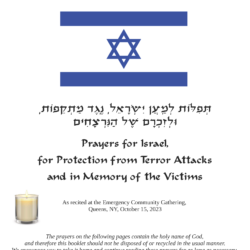TOGGLE COLUMNS (on/off):ADJUST COLUMN POSITIONS: select the column header cell and drag it where you want. show me!COPY INDIVIDUAL COLUMN(S): use CopyTables, a browser extension.
| Contribute a translation | Source (English) |
|---|---|
אֱלֹהֵינוּ אֱלֹהֵי כָל בָּשָר יוֹצְרֵֽנוּ יוֹצֵר בְּרֵאשִׁית |
Eloheinu, Elohei khol basar, Yotsreinu, Yotser bereshit [1] Liturgy from the Modim/Gratitude portion of the public repetition of the Amidah. “Our elo’ah (god) and elo’ah of all mortal creatures, the one who formed us, the one who formed creation.” |
Our God, God of all human beings, Who created each person with a spark of the Divine,[2] Find Genesis 1:26-27, Genesis 2:7, and Genesis 5:1-3. On the history of this idea, the scholar Rabbi Louis Jacobs (1920-2006) writes: “The belief that there is a special mystical ‘spark’ in every human breast can be traced back, in western mysticism, at least to Jerome in the fourth century. Both Bonaventura and Bernard of Clairvaux speak of this mystical organ; the latter, calling it scintillula, a small spark of the soul, and speaking of the nearness of God, said: ‘Angels and archangels are within us, but He is more truly our own who is not only with us but in us.’ However, both these mystics are anxious to prevent an identification of this mystical spark with the divine. Eckhart, on the other hand, embraces the identification, calling the spark, among other endearing names, das Kleidhaus Gottes, ‘the house in which God attires Himself ’. This and other pantheistic tendencies in Eckhart’s thought were condemned in the papal Bull of 1529…” (in “The Doctrine of the ‘Divine Spark’ in Man in Jewish Sources” Studies in Rationalism, Judaism and Universalism, ed. Raphael Loewe (Humanities: 1966) 87-114.) For those more familiar with Quaker theology, a similar belief is shared by George Fox (1624-1691). –Aharon Varady we pray for the urgent protection of human life. | |
אֲשֶׁר יַעֲשֶׂה אֹתָם הָאָדָם וָחַי בָּהֶם (ויקרא יח:ה) |
May we recall that You give life to all, and sustain all life through Your love, and may we remember Your instruction to us that preserving life is our highest duty in our service to You, Asher ya’aseh otam ha-Adam va-ḥai bahem (Leviticus 18:5) — that we fulfill our humanity in the safeguarding of human life. |
So, we pray: | |
May the destruction of innocent life come to an end. | |
May the ruin that comes from war cease now. | |
May each life be treated as a sacred treasure, as You have intended. | |
In a time of growing darkness, grant us the strength to be beacons of light, defenders of the vulnerable, and champions of justice. | |
May our hearts be filled with compassion, our minds with wisdom, and our hands with action, as we strive to safeguard the dignity and well-being of all Your children. | |
May none stand idly by the blood of any other. For we know that the lives, security and peace of us all — Jew, Muslim and Christian; Israeli and Palestinian, are bound up with each other, all as one. We are all one and connected. | |
סוּר מֵרָע וַעֲשֵׂה־טוֹב בַּקֵּשׁ שָלוֹם וְרָדְפֵֽהוּ (תהלים לד:טו) |
So, may we fulfill the words of the Psalms: Sur mé-ra va’aseh tov, baqesh shalom v’radféhu “Turn away from harm and do good; Seek peace and pursue it.” (Psalm 34:15) |
May we be among those who speak out and resist evil. | |
May peace and justice fill Your world. | |
And may we be among those who make peace and pursue justice. | |
Amen. |
This prayer was offered by Rabbi Andy Vogel and Rabbi Seth Goldstein and published at Rabbi Goldstein’s and Rabbi Vogel’s website on 3 April 2024. On Rabbi Vogel’s site, the prayer included the statement, “We encourage you to use the words of this prayer as you see fit; no attribution is needed.”
Source(s)
Notes
| 1 | Liturgy from the Modim/Gratitude portion of the public repetition of the Amidah. “Our elo’ah (god) and elo’ah of all mortal creatures, the one who formed us, the one who formed creation.” |
|---|---|
| 2 | Find Genesis 1:26-27, Genesis 2:7, and Genesis 5:1-3. On the history of this idea, the scholar Rabbi Louis Jacobs (1920-2006) writes: “The belief that there is a special mystical ‘spark’ in every human breast can be traced back, in western mysticism, at least to Jerome in the fourth century. Both Bonaventura and Bernard of Clairvaux speak of this mystical organ; the latter, calling it scintillula, a small spark of the soul, and speaking of the nearness of God, said: ‘Angels and archangels are within us, but He is more truly our own who is not only with us but in us.’ However, both these mystics are anxious to prevent an identification of this mystical spark with the divine. Eckhart, on the other hand, embraces the identification, calling the spark, among other endearing names, das Kleidhaus Gottes, ‘the house in which God attires Himself ’. This and other pantheistic tendencies in Eckhart’s thought were condemned in the papal Bull of 1529…” (in “The Doctrine of the ‘Divine Spark’ in Man in Jewish Sources” Studies in Rationalism, Judaism and Universalism, ed. Raphael Loewe (Humanities: 1966) 87-114.) For those more familiar with Quaker theology, a similar belief is shared by George Fox (1624-1691). –Aharon Varady |

“An Urgent Prayer for the Protection of Human Life, by Rabbi Andy Vogel and Rabbi Seth Goldstein” is shared through the Open Siddur Project with a Creative Commons Public Domain Dedication 1.0 Universal license.




![Independence Day prayer [4 July 1863] (Sabato Morais Ledger p. 22, clip no. 023)](https://opensiddur.org/wp-content/uploads/2022/08/Independence-Day-prayer-4-July-1863-Sabato-Morais-Ledger-p.-22-clip-no.-023-250x250.png)





Comments, Corrections, and Queries